Byte Byte Go
2M
428

Image Credit: Byte Byte Go
How Slack Supports Billions of Daily Messages
- Slack, originally developed from an internal communication tool for a video game company, evolved into a real-time collaboration platform handling millions of concurrent users and messages.
- Slack's architecture emphasizes separation of concerns and a push-first mentality for real-time updates, distinguishing it from traditional request-response applications.
- The core abstraction of persistent messaging ensures messages are not just displayed in real-time but also stored, indexed, and replayed when needed.
- The implementation of atomic broadcast in Slack guarantees validity, integrity, and total order in message delivery across the platform.
- Slack's evolution in message send flows shifted from prioritizing responsiveness to ensuring message persistence upfront, leading to a more reliable system.
- The introduction of Flannel, a geo-distributed cache for session bootstrapping, improved scalability by reducing the workload on the backend, especially for large organizations.
- Slack's architecture utilizes Kafka for durable message queuing and Redis for in-flight job data, ensuring reliability and efficient processing of messages.
- Overall, Slack's complex architecture prioritizes user trust, real-time messaging, and session consistency, adapting to challenges through distributed microservices and specialized components.
- Lessons from Slack's architecture include optimizing for latency, building resilience to failure, embracing complexity where necessary, and simplifying where possible.
Read Full Article
23 Likes
For uninterrupted reading, download the app